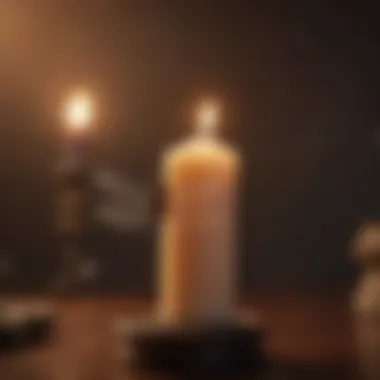Mastering the Dragonfly Doji Candle in Trading


Intro
In the vast universe of trading, where data oscillates like a pendulum, understanding each signal is pivotal. One such signal that stands out is the dragonfly doji candle. This unique candlestick pattern can illuminate the potential shifts in market sentiment and price trends, catching the discerning trader's eye. Its distinctive shape and implications can signify critical turning points, making it not just an interesting curiosity but a valuable tool in a trader's arsenal.
The dragonfly doji is much more than meets the eye. A novice might glance at it and see merely another candlestick on a chart. However, seasoned traders know its load is heavier; it carries insights that go beyond mere statistics. When it appears, it’s generally viewed as a sign of indecision among traders, often precipitating a possible reversal in the underlying trend.
Here is where our journey will begin, diving into the nuances of the dragonfly doji candle. We'll dissect its anatomy, understand critical terms related to it, and explore how its presence can inform decision-making in trading. By focusing on practical applications, we aim to arm investors with the knowledge they need to navigate the financial seas with greater confidence.
Prolusion to Candlestick Patterns
Candlestick patterns are a fundamental aspect of technical analysis, serving as visual representations of price movements over specific time periods. These patterns hold considerable weight in the world of trading, allowing traders to glean insights into market sentiment and potential future price action. In this article, we will explore the dragonfly doji candle, an important formation that may signal a shift in momentum. Understanding candlestick patterns, including their formation and implications, can greatly enhance one's trading acumen.
Definition of Candlestick Patterns
At their core, candlestick patterns are graphical representations created from four key price points: open, close, high, and low. Each candle displays this data for a particular time frame—be it minutes, hours, days, or even weeks. Typically, a candlestick consists of a body, which illustrates the range between the open and close prices, and wicks (or shadows) that extend above and below the body, representing the high and low prices reached during that time period. This distinct structure enables traders to interpret price action through visual analysis, leading to more informed decisions.
For instance, if a trader observes a long body with little wicking, it may signal strong buying or selling pressure. Conversely, if a eandle exhibits a small body and long wicks, it could indicate indecision among market participants. By recognizing these patterns, traders can form strategies and backtest their effectiveness to improve profitability over time.
Importance in Technical Analysis
Candlestick patterns play a crucial role in technical analysis, providing a nuanced view of market conditions that extends beyond mere price charts. They act as indicators of potential market reversals, continuations, or indecisiveness, enabling traders to react swiftly based on the prevailing sentiment.
- Market Sentiment Insight: Traders often rely on candlestick formations to gauge the mood of the market. A dragonfly doji, for example, emerging after a downtrend can signify a potential reversal, reflecting buyers gaining strength.
- Trend Confirmation: Certain patterns can either confirm an existing trend or indicate its potential reversal. For instance, a bullish engulfing pattern indicates strength in buying pressure, suggesting the possibility of a trend reversal to an upward trajectory.
- Risk Management: Leveraging candlestick patterns allows traders to identify crucial support and resistance levels. Understanding where these patterns form can improve entry and exit strategies, minimizing risks and maximizing rewards.
In light of these aspects, the study of candlestick patterns, particularly the dragonfly doji, emerges as a vital element for traders striving to navigate the complexities of financial markets. By dissecting these patterns, we can work towards mastering the art of trading.
The Dragonfly Doji Explained
The dragonfly doji is a special candlestick pattern that holds a prominent place in trading analysis, particularly for discerning market movements. Traders pay close attention to this pattern as it may suggest a shift in sentiment and potential for reversals in price actions. Understanding its mechanics can equip traders with the knowledge to make discussions backed by sound reasoning rather than gut feelings.
Characteristics of the Dragonfly Doji
A dragonfly doji features a unique shape that is recognizable at a glance. Its primary characteristic is the long lower shadow that often stretches down to near the support level, while the open and close prices occur at or near the same level at the top of the candle. This creates what appears almost like a "T" shape. Here are a few key points to consider:
- Body Position: The small body indicates that the market opened and closed at similar prices in a given trading session.
- Lower Shadow: The lengthy lower shadow reveals that sellers pushed the price down intra-session but did not manage to sustain that momentum by the time the closing bell rang.
- Color Significance: Traditionally, the color of the body (green or red) may offer insight into bullish or bearish sentiment, although the shape itself is more critical than color alone.
These traits make the dragonfly doji a go-to indicator for technical analysts. It often represents a struggle between buyers and sellers, leaving one to ponder who truly controls the market at that point.
Formation of the Dragonfly Doji
The formation of the dragonfly doji is a crucial aspect that traders must understand to utilize it effectively. This pattern arises in specific scenarios typically following a downtrend.
- Contextual Environment: The occurrence of a dragonfly doji is mostly noted after a pronounced downtrend, where market sentiment is predominantly bearish.
- Price Movement: During the trading session, if there’s substantial selling pressure early on, the price could drop significantly. However, the strength of buyers becomes apparent when they step in, pushing the price back up to the opening level towards the day's end.
- Confirmation: To establish its validity, traders often look for confirmation from subsequent candlesticks. A strong bullish follow-up candle can signal that buyers are indeed gaining momentum, while the absence of follow-through may indicate a false signal
Market Sentiment Reflected in Dragonfly Doji
The dragonfly doji is more than just a candlestick pattern; it’s a window into the collective mood of traders. Market sentiment plays a key role in determining price movements, and understanding how the dragonfly doji reflects this sentiment can offer deep insights. The emotions and expectations of market participants greatly influence price action, and this unique candlestick pattern often marks a tipping point. Recognizing this pattern can signify that sentiment is shifting, potentially paving the way for a bullish reversal.
Bullish Reversal Potential
A dragonfly doji appears when the opening and closing prices are around the same level, forming a distinct T-shape. This structure signals indecision among traders. Imagine a tug-of-war where the bulls and bears are fighting tooth and nail, but neither side can gain the upper hand. In this case, the end of a downward trend signals that buyers are starting to emerge, even if only tentatively.
This shift in sentiment highlights a crucial aspect of market behavior:


- Reversal signs: The appearance of a dragonfly doji at a support level or after a sustained downtrend can indicate a potential turnaround. Traders often take this as a cue to start looking for buy signals.
- Volume implications: The accompanying volume can further strengthen the bullish case. If the pattern emerges on increasing volume, it suggests stronger conviction among buyers, enhancing the likelihood of a price reversal.
Psychological Impacts on Traders
The psychological components surrounding the dragonfly doji are worth examining. In trading, emotions often drive decisions, sometimes leading to irrational behavior. The dragonfly doji encapsulates the struggle between fear and hope. When the market prints this pattern, it often signifies that market participants are wrestling with uncertainty, an instance where emotions can sway the outcomes.
Traders witnessing a dragonfly doji may experience several mental shifts:
- Cautious optimism: As traders see this pattern form, there might be a flicker of hope, leading them to believe the downtrend is on the verge of reversal.
- Fear of missing out (FOMO): As others begin to jump in on the bullish sentiment, non-participants might feel pressured to act quickly, potentially entering trades without thorough analysis.
- Increased activity: The appearance of a dragonfly doji can lead to heightened trading volumes as participants adjust their positions based on the perceived shift in sentiment. This can culminate in amplified volatility, making entry and exit points critical to manage carefully.
"In trading, understanding the interplay of trader psychology with market formations like the dragonfly doji can significantly enhance decision-making and risk management."
In summary, the dragonfly doji serves as a critical indicator of market sentiment. Its formation often indicates a beautiful confluence of psychological dynamics that may not just sway individual traders but ripple through the broader market. Recognizing these patterns and their implications empowers traders to better navigate the complexities of financial markets.
Identifying Valid Dragonfly Doji Candles
Recognizing valid dragonfly doji candles is a crucial stage in integrating this pattern into your trading strategy. These candles can signal potential reversals, but if not interpreted correctly, they might lead you down a rabbit hole of uncertainty and incorrect trades. Several factors contribute to verifying the authenticity of a dragonfly doji, making this an essential skill for traders looking to enhance their market acumen.
Volume Considerations
Volume serves as a significant indicator when it comes to validating the dragonfly doji candle. Simply put, high trading volume amplifies the reliability of the doji's signal. When a dragonfly doji forms on a day with elevated volume, it reflects a strong interest from traders, suggesting that the potential for a reversal is more grounded.
- Unusual Volume Patterns: Pay attention to irregular volume spikes that accompany the dragonfly doji. A candle with increased volume indicates that more market participants have entered the fray, lending credence to the potential reversal.
- Comparison with Previous Days: Assessing the current day’s volume against prior sessions is also vital. If the volume is significantly above the average, it provides an additional layer of validation. Traders often look for volume that exceeds the average of the last few sessions to consider the signal more reliable.
Without volume to back it up, a dragonfly doji may just be a candle floating alone on the charts.
Contextual Market Analysis
Context is your compass. Understanding the overall market landscape when a dragonfly doji appears is essential. Evaluating the surrounding price action and economic indicators can lend further clarity to whether the signal is valid.
- Previous Trend Direction: Make sure to examine the trend prior to the appearance of the dragonfly doji. A doji following a sustained downtrend holds more weight than one that appears amid choppy trading. If the market has been consistently bearish, a dragonfly doji could suggest that sellers are losing their grip, hinting at a possible reversal.
- Support Levels: The positioning of the doji relative to support or resistance levels can also inform its validity. A dragonfly doji developing right at a support level suggests that this price point is significant, possibly indicating that buyers are stepping in. This interaction can signal not just a short-term reversal, but could also hint at longer-term opportunities.
- Economic Factors: Keep an eye on external factors like economic data releases or geopolitical events. Such developments can significantly sway market sentiment and influence the behavior of traders. A dragonfly doji emerging during pivotal moments, such as after major news, can present a crucial insight into the changing dynamics of supply and demand.
Identifying the Dragonfly Doji requires layering the candle’s characteristics with supporting metrics. It’s not just about what you see on the chart; it’s about crafting an informed narrative around it.
By assessing both volume and market context, traders can better determine the validity of a dragonfly doji candle. This meticulous approach not only sharpens trading strategies but also fosters a more profound understanding of market psychology.
Strategic Applications of the Dragonfly Doji
The Dragonfly Doji is more than just a simple pattern on a chart; it serves as a critical tool for traders aiming to grasp market sentiment and make informed decisions. When wielded correctly, this candle can be a beacon of insight into potential bullish reversals. Understanding its strategic applications enables traders to incorporate this pattern into their overall trading strategies effectively.
Incorporating with Other Indicators
While the Dragonfly Doji can stand on its own, it becomes even more powerful when combined with other technical indicators. Many traders find it beneficial to align the doji with tools like moving averages or the Relative Strength Index (RSI).
- Moving Averages: Using the Dragonfly Doji in conjunction with a moving average can provide a clear picture of trend direction. For instance, if a Dragonfly Doji forms near a significant moving average, it could indicate a possible reversal point where the market may bounce back.
- RSI: The RSI measures the momentum of price movements. If a Dragonfly Doji appears while the RSI is indicating oversold conditions, this strengthens the case for a potential bullish reversal.
Incorporation of these indicators provides additional confirmation, reducing the likelihood of falling for false signals. While no strategy is foolproof, the blend of candlestick patterns with established indicators can elevate trading proficiency.
Setting Entry and Exit Points
Deciding when to enter or exit a position can be a daunting task. The Dragonfly Doji offers clarity here, presenting a straightforward foundation for making these critical choices.
- Entry Points: After the formation of a Dragonfly Doji, traders can look for a confirmation candle in the next trading period. A bullish confirmation, such as a green candle closing above the doji, can trigger an entry. This is often perceived as a signal that buying pressure is increasing.
- Exit Points: Setting exit points using a Dragonfly Doji requires judgment on risk versus reward. Many traders might establish exit targets near previous resistance levels. Alternatively, they might use trailing stops to lock in profits as the market moves in their favor.
"The Dragonfly Doji isn’t just a marker of potential change; it's a roadmap to navigating entry and exit decisions in volatile markets."


In summary, the strategic applications of the Dragonfly Doji are multifaceted. By incorporating it with other indicators and using it as a guide for setting entry and exit points, traders can enhance their decision-making process, thereby increasing their chances of success in the ever-changing landscape of trading.
Limitations of the Dragonfly Doji
While the dragonfly doji is a striking candlestick pattern that can hint at potential reversals, it’s vital to recognize its limitations. Like any tool in a trader's arsenal, understanding where it might falter can keep traders from misstepping in their strategies. Grasping these constraints allows for a more nuanced application of this pattern in various market scenarios. The dragonfly doji can paint a promising picture, but a deeper look reveals both false signals and the necessity for layered risk management.
False Signals in Sideways Markets
The dragonfly doji shines in trending markets—its very essence often signals a shift in momentum. However, in a sideways or ranging market, this candle can lead to confusion. Traders might see a doji forming and interpret it as a bullish signal, only to be led down a rabbit hole where price movement fails to materialize convincingly.
When prices are stagnating, the dragonfly doji can easily be just a momentary pause, misrepresenting potential bullish action. It's akin to a mirage in the desert; it looks clear and inviting until you get closer and realize it’s nothing but an illusion. Therefore, traders should stay on alert, keeping in mind that just because they spot a doji doesn’t automatically mean change is afoot.
In practical terms, here are some key points to consider when using dragonfly doji in sideways markets:
- Confirm with Volume: Check trading volume to gauge interest; a doji without substantial volume may lack validity.
- Use Additional Indicators: Relying just on a doji can be risky. Combine it with other indicators like RSI or moving averages for confirmation.
- Observe Market Sentiment: Stay attuned to news or macroeconomic indicators that could be affecting price action.
In the world of trading, ambiguity is often your greatest adversary. Recognizing when a candlestick does not provide clear signals is crucial.
Risk Management Practices
Even the most astute traders can be caught off guard by the dragonfly doji’s limitations. So, fortifying a trading strategy with solid risk management practices becomes critical. One way to manage risk involves employing well-defined stop-loss orders. Establishing a stop-loss slightly below the dragonfly doji can help mitigate potential losses from adverse moves.
Another component of effective risk management includes position sizing. Avoid placing too much capital on a single trade signaled by a doji without thorough analysis. Diversifying positions can help cushion the blow if the market goes the other way.
Here are practical applications of risk management while trading dragonfly doji:
- Set Clear Stop-Loss Levels: Determine a precise level where the trade should be exited to limit losses.
- Risk-Reward Ratio: Ensure the potential reward of the trade outweighs the risk. A common guideline is a minimum ratio of 1:2.
- Trade Size Considerations: Take into account your overall capital and how much of it you are willing to risk on this particular signal.
In sum, while the dragonfly doji can be a valuable asset in a trader’s toolkit, acknowledging its limitations enables a more robust trading framework. By honing in on market conditions, maintaining effective risk management, and avoiding reliance solely on this pattern, traders can enhance their decision-making processes.
Real-World Examples of Dragonfly Doji
Understanding the practical applications and implications of the Dragonfly Doji goes a long way in enriching a trader's strategy. Real-world examples illustrate how this candle can play a pivotal role in market movements. Delving into actual cases helps in grasping its dynamics—showcasing not only its potential for signaling reversals but also the accompanying psychology and market sentiment.
Case Studies in Stock Markets
Let’s consider a couple of stock market case studies that showcase the power of the Dragonfly Doji. One striking instance occurred with Microsoft. On a specific day, after a prolonged downtrend, the stock formed a Dragonfly Doji on the daily chart. The opening price was below the previous day's close, but by the end of that trading session, buyers pushed the price back up to close right at the opening level. Traders recognized this formation as a strong bullish reversal signal since it indicated a battle between bulls and bears, with bulls eventually taking control.
Another example can be seen in Tesla’s stock history. During a significant drop, a Dragonfly Doji appeared precisely at a critical support level. The candle signaled indecision among traders. Shortly thereafter, the price rallied, affirming the reliability of the pattern in this context. The reversal from this Doji demonstration emphasized how vital it is to watch for such formations with volume support in nearby timeframes.
In both instances, the Dragonfly Doji did not operate in a vacuum. They both appeared within larger trends and were influenced by broader market sentiment and external news. For instance, Microsoft was experiencing favorable earnings reports which played a significant role in traders’ reactions.
Comparative Analysis with Other Patterns
When assessing the robustness of the Dragonfly Doji, a comparison with other candlestick patterns reveals its unique attributes. For instance, consider the Hammer. Both candles share similar appearances, often signaling potential reversals. However, the real distinction lies in the context of their formations. The Hammer typically appears in downtrends, indicating that the price has rejected lower levels before moving higher, while the Dragonfly Doji suggests a stronger market indecision followed by buying pressure, particularly if the price returns to the opening level.
Another pattern worth comparing is the Shooting Star. This is on the contrary—a bearish signal. It resembles the Dragonfly Doji, with its short body at the bottom, yet it appears after a price advance. This difference in trend alignment is crucial; traders recognize that while the Dragonfly Doji signals possible bullish reversals, the Shooting Star warns of potential downward trends.
In summation, while the Dragonfly Doji remains a powerful tool in a trader's arsenal, juxtaposing it with other candlestick patterns enhances strategy formulation, ensuring more informed trading decisions. It’s pertinent to always assess the broader context when interpreting these signals, as they are indicators rather than guarantees.
Remember, successful trading often relies on understanding market structures rather than just patterns.
The Role of Timeframes in Analyzing Dragonfly Doji
Understanding the dragonfly doji requires a keen eye on the timeframes utilized in trading. Timeframes play a crucial role in how this candle is interpreted, as they can significantly affect the signals drawn from the chart patterns. Analyzing the dragonfly doji across different timeframes can help traders determine potential entry and exit points more effectively.


Short-Term vs Long-Term Trading
In trading, strategies often oscillate between short-term and long-term perspectives. Each approach can yield distinct insights from the dragonfly doji candle.
- Short-Term Trading: For traders who focus on quick gains, the dragonfly doji appearing on lower timeframes—like 5-minute or 15-minute charts—could signal an imminent price reversal. The rapid pace of price movements means that observing dragonfly dojis in these contexts often leads to opportunistic trades. However, it’s vital to recognize that the market may not always validate the reversal, making risk management critical.
- Long-Term Trading: On the flip side, long-term traders may analyze the dragonfly doji on daily or weekly charts. Here, the doji serves as an indicator of market sentiment and potential shifts in trend over an extended period. These candles, when confirmed by subsequent price action, can provide a solid basis for longer-term positions. Therefore, traders should employ patience in waiting for confirmation moves, as impulsive decisions might lead to unfavorable outcomes.
Timeframe Impact on Signal Validity
The importance of considering timeframes in trading cannot be overstated, particularly when analyzing the validity of a dragonfly doji signal. The validity of this candlestick pattern can fluctuate depending on the timeframe selected:
- Support and Resistance Levels: Signals derived from a daily chart might carry more weight due to the influence of broader market movements and established support or resistance levels. A dragonfly doji emerging near significant resistance on a daily chart may be seen as more credible than one on a 1-minute chart, regardless of the volatility at that moment.
- Market Trends: A dragonfly doji that forms during a prevailing downtrend on a longer timeframe suggests a reversal might be more likely than in an uptrend, where the context could indicate a retracement instead. Hence, traders must apply critical thinking and combine information from various timeframes to assess the strength of the signal.
In essence, a dragonfly doji is just one piece of the puzzle. It's critical to look beyond the pattern, integrating timeframes into the analysis for a well-rounded view.
- Confirmation: Look for robust confirmation—like a subsequent bullish candle—on the chosen timeframe. Establishing that the trend is changing can significantly bolster the validity of the dragonfly doji.
Ultimately, the role of timeframes shapes the perception and applicability of the dragonfly doji candle. By understanding how different timeframes can alter the interpretation, traders can enhance their decision-making process, leading to more strategic trading outcomes.
Tools and Resources for Trading
Understanding the Dragonfly Doji Candle in trading is not just about recognizing its pattern on a chart. It extends beyond that, diving into the necessary tools and resources available for traders to enhance their skills and strategies. In essence, these tools serve as the backbone for informed trading decisions that can lead to successful outcomes. With effective tools at their disposal, traders can analyze patterns with precision and set strategies that align with their trading goals.
Software and Platforms
In today’s digital age, the right software can be a game changer for traders. Various trading platforms allow for a detailed analysis of candlestick patterns, including the dragonfly doji. Programs like MetaTrader 4/5 and TradingView offer robust charting capabilities, making it easier to identify setups and execute trades seamlessly.
These platforms typically feature:
- Customizable indicators: Traders can modify visual elements and indicators to suit their preferences, allowing for a more personalized trading experience.
- Backtesting tools: This helps traders test strategies against historical data, providing insights on the strategies' potential efficacy.
- Real-time data: Instant access to live market data is crucial for making well-informed decisions, especially when monitoring patterns like the dragonfly doji.
Moreover, these platforms often come with integrated social capabilities. For instance, you can share strategies or view other traders’ analyses, further enriching the learning experience.
Educational Resources
Education remains vital for deepening one’s understanding of trading, particularly for complex patterns like the dragonfly doji. Various educational resources can enhance knowledge and boost trading skills.
- Online Courses and Webinars: Websites like Udemy and Coursera offer courses focused on technical analysis and specific candlestick formations, including the dragonfly doji. These can provide structured learning experiences, from beginner to advanced levels.
- Trading Forums and Communities: Platforms such as Reddit or dedicated trading forums offer spaces for traders to discuss and dissect different strategies and patterns. Engaging with a community can provide valuable insights and peer support.
- Books: Literature on technical analysis remains a cornerstone for many traders. Titles such as Technical Analysis of the Financial Markets by John J. Murphy can be excellent resources for understanding the broader context of candle patterns.
- YouTube Channels: Numerous content creators focus on trading strategies and technical analysis, offering tutorials that cover the dragonfly doji and its implications in market analysis.
"The most dangerous thing a trader can do is to operate without the right knowledge and tools. Success often hinges not just on intuition, but on informed decision-making backed by data and education."
By leveraging these tools and educational resources, traders can better position themselves to react to market movements, making it essential to invest time and resources into learning and strategizing effectively.
Epilogue: Mastering the Dragonfly Doji
The dragonfly doji serves as a beacon for traders navigating the intricate waters of market volatility. Mastering its nuances not only enriches one’s technical analysis but also empowers traders to make informed decisions. Recognizing the formation and psychological significance of this candlestick pattern allows traders to position themselves strategically, ultimately enhancing their profitability.
Summarizing Key Points
In this article, we explored several facets of the dragonfly doji. Here’s a recap:
- Definition: A dragonfly doji appears when the open and close of the candlestick are at the same level, with a long lower shadow and little to no upper shadow.
- Market Sentiment: This pattern reflects a potential bullish reversal, indicating that buyers may regain control after a prevailing downtrend.
- Identification: Recognizing volume and contextual market factors is crucial in validating the dragonfly doji as a reliable signal.
- Strategic Application: Employing this pattern alongside other indicators can lead to more effective trading strategies, including optimal entry and exit points.
- Limitations: It's essential to understand that the dragonfly doji can produce false signals, especially in sideways markets. Implementing robust risk management practices can mitigate these pitfalls.
By assimilating these concepts, traders can enhance their ability to perceive market shifts and apply the dragonfly doji effectively in their trading strategies.
Future Trends in Candlestick Trading
The world of trading is always evolving, and candlestick patterns are no exception. The future of candlestick trading is likely to embrace further integration with technology. Here are a few potential trends:
- AI and Machine Learning: Algorithms are increasingly being developed to recognize candlestick patterns, including the dragonfly doji, and assess market behavior in real-time. This could make trading decisions faster and potentially more accurate.
- Increased Focus on Behavioral Finance: Traders are realizing the impact of psychology on market trends, leading to a deeper understanding of how patterns like the dragonfly doji reflect trader sentiment.
- Education and Resources: As access to trading tools and educational resources expands, more traders are expected to use sophisticated strategies based on traditional patterns, possibly enhancing the awareness of the dragonfly doji.
The journey of mastering the dragonfly doji candle is ongoing. With an informed mindset and adaptive strategies, traders can position themselves advantageously in the ever-changing landscape of financial markets.















